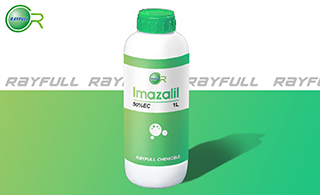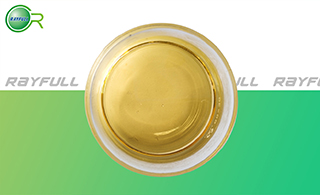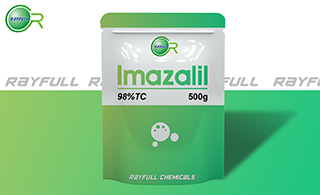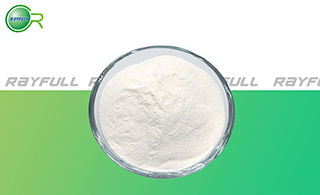Imazalil



 抑霉唑
抑霉唑
Introduction: Imazalil is a systemic imidazole fungicide used to control a wide range of fungi on fruit, vegetables and ornamentals, including powdery mildew on cucumber and black spot on roses. Imazalil is also used as a seed dressing and for postharvest treatment of citrus, banana and other fruit to control storage decay. Under natural conditions it is less likely that resistant strains of fungi will develop with imazalil than with some of the other fungicides. Imazalil is a general use pesticide.
Common name: Imazalil
Another name: Enilconazole; Deccozil; Chloramizol; Fungaflor; etc.
Chemical name: (RS)-1-(β-allyloxy-2,4-dichlorophenylethyl)imidazole
Empirical formula: C14H14Cl2N2O
Structural formula:

Mol. Weight: 297.18 g/mol
CAS No.: 35554-44-0
Specifications
Leading Imazalil supplier
Imazalil 98% TC
Imazalil 50% EC
Packing:
BULK PACKING
Powder: 25kg/Bag, 25kg/Drum, 50kg/Drum etc.
Liquid: 200L/Drum, 20L/Drum, 10L/Drum etc.
SMALL PACKING
Powder: 1kg/Alu bag, 500g/Alu bag, 200g/Alu bag, 100g/Alu bag, 50g/Alu bag, 15g/Alu bag etc.
Liquid: 5L/Drum, 1L/Bottle, 500ml/Bottle, 250ml/Bottle, 100ml/Bottle, 50ml/Bottle etc.
Customerized packing label
Imazalil FAO standard
Professional registration
HAZARDS IDENTIFICATION
Hazard statement(s)
H301 (14.29%): Toxic if swallowed.
H302 (85.71%): Harmful if swallowed.
H318 (100%): Causes serious eye damage.
H332 (100%): Harmful if inhaled.
H400 (93.65%): Very toxic to aquatic life.
H410 (100%): Very toxic to aquatic life with long lasting effects.
Precautionary statement(s)
P261: Avoid breathing dust/fume/gas/mist/vapors/spray.
P264: Wash ... thoroughly after handling.
P270: Do not eat, drink or smoke when using this product.
P273: Avoid release to the environment.
P280: Wear protective gloves/protective clothing/eye protection/face protection.
P301+P310: IF SWALLOWED: Immediately call a POISON CENTER/doctor/...
P301+P312: IF SWALLOWED: call a POISON CENTER/doctor/... IF you feel unwell.
P304+P312: IF INHALED: Call a POISON CENTER/doctor/... if you feel unwell.
P305+P351+P338: IF IN EYES: Rinse cautiously with water for several minutes. Remove contact lenses if present and easy to do - continue rinsing.
P310: Immediately call a POISON CENTER or doctor/physician.
P312: Call a POISON CENTER or doctor/... if you feel unwell.
P321: Specific treatment (see ... on this label).
P330: Rinse mouth.
P391: Collect spillage.
P405: Store locked up.
P501: Dispose of contents/container to an approved waste disposal plant.
Supplemental Hazard Statements: none.
MAMMALIAN TOXICOLOGY
Acute toxicity: 1) Acute oral LD50 for rats is 227 mg/kg. 2) Acute dermal LD50 for rats is >2000 mg/kg. 3) Acute inhalation toxicity LC50 (4 h) for rats is 1.84 mg/L. 4) Skin irritation: Slightly irritating to skin (rabbits). 5) Eye irritation: Moderately irritating to eyes (rabbits). 6) Skin sensitization for guinea pig: Sensitizer (Magnusson & Kligman method).
NOEL: In a two-generation study, the NOAEL for maternal toxicity was 20 mg/kg bw per day on the basis of reduced body-weight gain.
ADI (JMPR) 0-0.03 mg/kg b.w. [2001, 2005]
Classification:
WHO Classification: II (Moderately hazardous)
EC Risk Classification: Xn - Harmful: R20/22m, R41; N - Dangerous for the environment: R50, R53
US EPA Classification (formulation): II (Warning - Moderately toxic)
ECOTOXICOLOGY
Effect on birds: Acute oral LD50 for Japanese quail is 510 mg/kg. Effect on fish: Acute LC50 (96 h) for Rainbow trout is 1.48 mg/l. Effects on aquatic invertebrates: Acute EC50 (48 h) for Daphnia magna is 3.5 mg/l. Effects on algae: Acute 72 hour EC50 for Raphidocelis subcapitata is 0.87 mg/l. Effects on bees: contact acute 48 hour LD50 is 39 μg/bee, oral acute 48 hour LD50 is 35.1 μg/bee. Effects on earthworms: Acute 14 day LC50 is 541 mg/kg.
ENVIRONMENTAL FATE
Animals In rats, following oral administration, 90% is eliminated in the metabolised form within 4 days. Plants In plants, imazalil is transformed into a-(2,4-dichlorophenyl)-1H-imidazole-1-ethanol. Soil/Environment DT50 (field) 4-5 d; DT90 (field) 54-68 d. Soil adsorption K 182 (clay loam), 209 (sandy loam), 68 (sandy soil).
Usage: Imazalil was introduced by Janssen Pharmaceutica. It is a fungicide used to control a wide range of fungi including Tilletia and Helminthosporium spp. on fruit, vegetables and ornamentals.
Application: Biochemistry Steroid demethylation (ergosterol biosynthesis) inhibitor. Mode of action Systemic fungicide, with protective and curative action. Uses Control of a wide range of fungal diseases on fruit, vegetables, and ornamentals, e.g. powdery mildews on cucurbits and ornamentals; powdery mildew on roses; storage diseases (particularly Penicillium, Gloeosporium, Phomopsis, Phoma spp., etc.) of citrus fruit, pome fruit, bananas, and seed potatoes. Also used as a seed dressing, for control of diseases (particularly Fusarium and Helminthosporium spp.) of cereals. It is particularly active against benzimidazole-resistant strains of plant-pathogenic fungi. Typical use rates are: for seed treatment 4-5 g/100 kg seed; for ornamentals and vegetables 5-30 g/hl; and for post-harvest treatment 2-4 g/t fruit.







